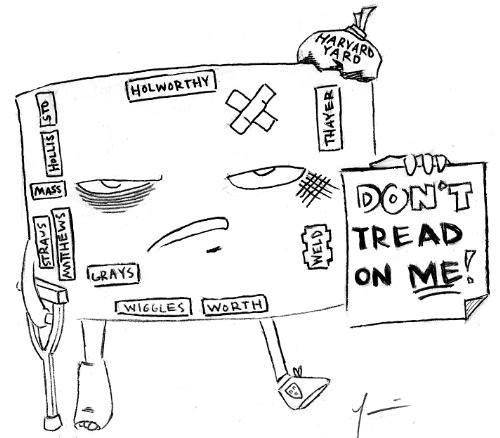
News
Summers Will Not Finish Semester of Teaching as Harvard Investigates Epstein Ties

News
Harvard College Students Report Favoring Divestment from Israel in HUA Survey

News
‘He Should Resign’: Harvard Undergrads Take Hard Line Against Summers Over Epstein Scandal

News
Harvard To Launch New Investigation Into Epstein’s Ties to Summers, Other University Affiliates

News
Harvard Students To Vote on Divestment From Israel in Inaugural HUA Election Survey
First-years on the Grass, Alas
Comment

Among the many liberties American society affords us all is the freedom to walk on the grass. It is a freedom often taken for granted by those native to these parts, but for those of us who hail from the other side of the Atlantic, it is quite astonishing to see those libertines studying, sleeping, convening and playing on the green surfaces of the Yard. It is not, however, a practice of which I approve. Rather, I tend to see the grass as a potential source of pride for our beloved University.
There are admittedly few fields in which the Cambridge on the other side of the sea (the one I, with European bias, still tend to think of as the “real” Cambridge) can claim to beat the home of veritas, but the open field is definitely one of them. One of my most indelible memories of a visit to King’s College last summer is that lustrous, uniform surface of perfect green. It has been tended for centuries and is one of the college’s status symbols, along with the chapel and the wine cellar (which you should definitely check out, should you ever get the chance).
The University in this Cambridge, instead, can offer us only weedy looking patches, worn at the edges by overworked students cutting corners to get to section on time. Those corners, and the dirt in between them, are not the symbol of power and beauty they could be. Think of the symbolism exuding from thriving, refulgent green spaces: vigour, growth, abundance, fertility! The image projected currently around the abodes of the new students is of life taking root only with trouble, of impeded growth on barren soil. Hardly encouraging for an impressionable class of first-years.
I realize that prohibition does not go down well in the United States (alas, one lamentable exception—the puritanical drinking age). But there are benefits to be gained even from the enforcement of restrictive botanical rules. A King’s student once excitedly told me of the one day of the year in which students are allowed on the lawns for a party. Her trembling tone of voice implied all the sensuality of such a moment of transgression, and she went on to describe the secret joys of stealing barefoot across the lawns at night. In this land where everything is flaunted, the erotism deriving from concealment and restrictions is definitely lacking.
It must be said that the efforts of the workers who look after Harvard’s lawns are valiant. They mow and water all too vigorously, in fact: the sprinkler system in front of Lamont recently caught me by surprise, nearly giving my companion, Friedrich Nietzsche, a most unwelcome bath. The sorry state of our grass is not imputable to the gardeners, rather, it is the pleasure and speed-seeking students who rob their work of its fruit.
I do not suggest that all green surfaces should have restricted access. It is a question of measure. For example, who cares about the lawn in front of Canaday? It couldn’t improve its surroundings much, anyway. And perhaps certain areas at certain times could be granted for games or relaxation. But cutting corners, or leaving the paths? We should not tolerate those anymore. With a few simple precautions, we will finally prove that Americans have a sense of beauty too and that the last remaining claims of Old World superiority are unfounded.
—Alexander Bevilacqua is an editorial comper.
Want to keep up with breaking news? Subscribe to our email newsletter.
